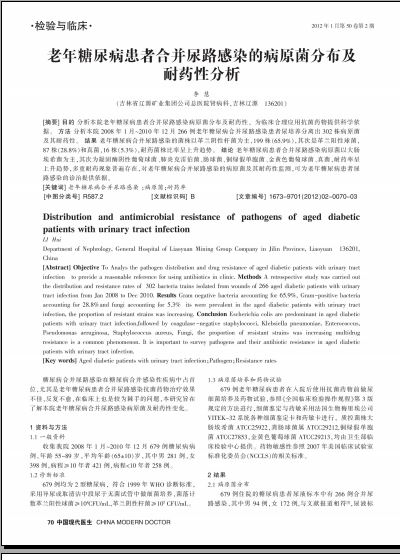老年糖尿病患者合并尿路感染的病原菌分布及耐药性分析
 |
| 第1页 |
参见附件。
[摘要] 目的 分析本院老年糖尿病患者合并尿路感染病原菌分布及耐药性,为临床合理应用抗菌药物提供科学依据。 方法 分析本院2008年1月~2010年12月266例老年糖尿病合并尿路感染患者尿培养分离出302株病原菌及其耐药性。 结果 老年糖尿病合并尿路感染的菌株以革兰阴性杆菌为主,199株(65.9%),其次是革兰阳性球菌,87株(28.8%)和真菌,16株(5.3%),耐药菌株比率呈上升趋势。 结论 老年糖尿病患者合并尿路感染病原菌以大肠埃希菌为主,其次为凝固酶阴性葡萄球菌、肺炎克雷伯菌、肠球菌、铜绿假单胞菌、金黄色葡萄球菌、真菌,耐药率呈上升趋势,多重耐药现象普遍存在,对老年糖尿病合并尿路感染的病原菌及其耐药性监测,可为老年糖尿病患者尿路感染的诊治提供依据。
[关键词] 老年糖尿病合并尿路感染 ;病原菌;耐药率
[中图分类号] R587.2 [文献标识码] B [文章编号] 1673-9701(2012)02-0070-03
Distribution and antimicrobial resistance of pathogens of aged diabetic patients with urinary tract infection
LI Hui
Department of Nephrology, General Hospital of Liaoyuan Mining Group Company in Jilin Province, Liaoyuan 136201, China
[Abstract] Objective To Analys the pathogen distribution and drug resistance of aged diabetic patients with urinary tract infection to provide a reasonable reference for using antibiotics in clinic. Methods A retrospective study was carried out the distribution and resistance rates of 302 bacteria trains isolated from wounds of 266 aged diabetic patients with urinary tract infection from Jan 2008 to Dec 2010. Results Gram negative bacteria accounting for 65.9%, Gram-positive bacteria accounting for 28.8%and fungi accounting for 5.3% its were prevalent in the aged diabetic patients with urinary tract infection, the proportion of resistant strains was increasing. Conclusion Escherichia colis are predominant in aged diabetic patients with urinary tract infection,followed by coagulase-negative staphylococci, Klebsiella pneumoniae, Enterococcus, Pseudomonas aeruginosa, Staphylococcus aureus, Fungi, the proportion of resistant strains was increasing multidrug resistance is a common phenomenon. It is important to survey pathogens and their antibiotic resistance in aged diabetic patients with urinary tract infection.
[Key words] Aged diabetic patients with urinary tract infection;Pathogen;Resistance rates
糖尿病合并尿路感染在糖尿病合并感染性疾病中占首位,尤其是老年糖尿病患者合并尿路感染抗菌药物治疗效果不佳,反复不愈,在临床上也是较为棘手的问题,本研究旨在了解本院老年糖尿病合并尿路感染病原菌及耐药性变化。
1 资料与方法
1.1 一般资料
收集我院2008年1月~2010年12月679例糖尿病病例,年龄55~89岁,平均年龄(65±10)岁,其中男 281例,女398例,病程≥10年者421例,病程<10年者258例。
1.2 诊断标准
679例均为2型糖尿病,符合1999年WHO诊断标准,采用导尿或取清洁中段尿于无菌试管中做细菌培养,菌落计数革兰阳性球菌≥104CFU/mL,革兰阴性杆菌≥105 CFU/mL。
1.3 病原菌培养和药物试验
679例老年糖尿病患者在入院后使用抗菌药物前做尿细菌培养及药物试验,参照《全国临床检验操作规程》第3版规定的方法进行,细菌鉴定与药敏采用法国生物梅里埃公司VITEK-32系统各种细菌鉴定卡和药敏卡进行,质控菌株大肠埃希菌ATCC25922,粪肠球菌属ATCC29212,铜绿假单胞菌ATCC27853,金黄色葡萄球菌ATCC29213,均由卫生部临床检验中心提供。药物敏感性参照2007年美国临床试验室标准化委员会(NCCLS)的相关标准。
2 结果
2.1 病原菌分布
679例住院的糖尿病患者尿液标本中有266例合并尿路感染,其中男 94例,女 172例,与文献报道相符[1],尿液标本中共分离病原菌302株,其中36例分离出2种病原菌(合并真菌感染6例),见表1。
2.2 病原菌的耐药率
见表2。
3 讨论
我院老年糖尿病合并尿路感染患者中分离的主要病原菌为革兰阴性杆菌,其中以大肠埃希菌居首位,共124株,占41.0%,其次凝固酶阴性葡萄球菌42株,占13.9%,与文献报道[2,3]相符。肺炎克雷伯菌39株,占12.9%,肠球菌属(粪肠球菌23株,屎肠球菌13株)36株,占11.9%,铜绿假单胞菌26株,金黄色葡萄球菌9株,真菌16例,其他阴杆菌10株。
在124株大肠埃希菌中产ESBLs菌株52株,占41.9%,39株肺炎克雷伯菌产ESBLs菌株13株,占33 ......
您现在查看是摘要介绍页,详见PDF附件(2729kb)。